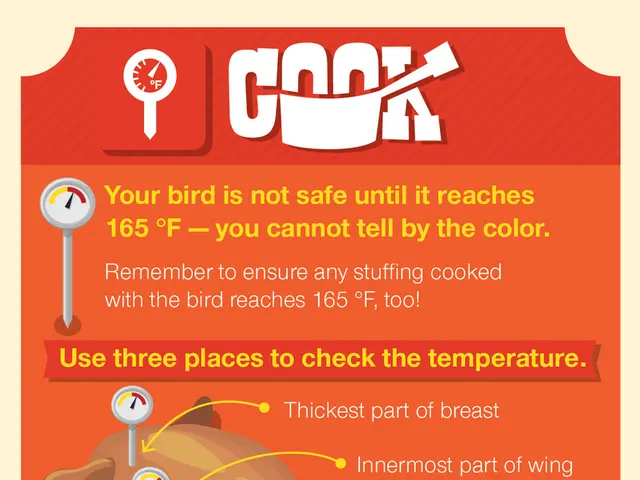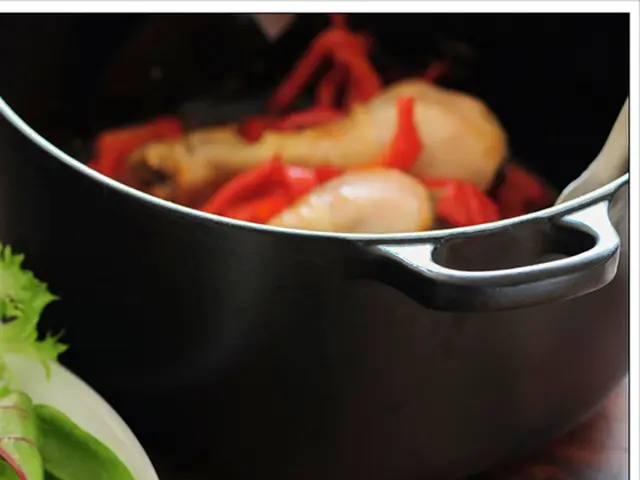Reheated Rice Contamination by Bacillus Cereus Causing Illnesses
A Warning About Leftover Rice
Fancy a bowl of that leftover rice? Hold your horses! Rice could potentially make you sick if not stored properly. Here's the lowdown on reheated rice syndrome and how to stay safe.
Why should you be worried about that dinner leftover?
The bogeyman lurking in your kitchen might surprise you – it's the bacteria Bacillus cereus. Unlike common foodborne culprits such as Salmonella and E. coli, these spore-forming bacteria can survive cooking and reheating, thanks to their heat-resistant toxins. Even if you're killing the bacteria with heat, you're not necessarily destroying the toxins[1].
Once Bacillus cereus multiplies in the "danger zone" of 40°F to 140°F, it can give you a terrible case of vomiting, cramps, and diarrhea[2]. Don't worry too much – most people can handle a small amount of these toxins, but it's important to keep tabs on your leftovers to stay safe.
Are there other foods that harbor these sneaky bacteria?
Although people often call this fried rice syndrome, the bacteria in question can inhabit various food types. Apart from rice, Bacillus cereus also thrives on pasta, potatoes, and grains like barley and wheat[3]. Another spore-forming bacteria, Clostridium perfringens, is commonly found on gravy and meats, while Staphylococcus aureus lurks in salty foods like ham[4].
What are the symptoms of affected rice?
Fortunately, symptoms from Bacillus cereus kick in within 6 to 12 hours, which is faster than most foodborne illnesses. Expect nausea, cramps, and an awful lot of vomiting. If the bacteria continue to multiply in your intestines, you might experience severe diarrhea[5]. However, a bout with Bacillus cereus should only last one to two days, and you'll be back to your regular self in no time.
If I get sick from reheated rice, will I die?
In most cases, the prognosis for reheated rice ailments is good. Although there have been rare instances of Bacillus cereus causing severe infections, organ failure, and even death[6], these cases are quite uncommon. In fact, getting sick from Bacillus cereus is not particularly likely, compared to other sources of foodborne illnesses.
So, don't stress too much about your leftover rice. Just follow these simple tips to ensure you're enjoying a healthy and safe meal.
How can I prevent food poisoning from rice?
The key to avoiding Bacillus cereus food poisoning lies in proper handling and storage:
- Cook smaller portions instead of large batches.
- Don't leave rice out for longer than an hour or two.
- Use a thermometer to check the temperature of your rice – it should be at least 150°F (65.5°C) if left in a rice cooker on the "Keep Warm" setting.
- After cooking, break up the rice into smaller portions and refrigerate immediately in storage containers.
- Don't leave a covered pot of hot rice in the fridge to cool – this will trap heat and take a long time to cool.
- Eat the leftover rice within a few days, or even sooner if you're extra cautious.
- When in doubt, throw it out!
By keeping these tips in mind, you can savor your rice dishes without fear of a potentially sickening encounter with Bacillus cereus.
Enrichment Data:
Bacillus cereus and Food Poisoning
Bacillus cereus is a spore-forming bacterium that can cause food poisoning through the production of two main types of toxins: a diarrheal toxin and an emetic toxin. The emetic toxin, known as cereulide, is particularly associated with rice and other starches when they are improperly cooled and reheated[7].
[1] Centers for Disease Control and Prevention. (n.d.). Bacillus cereus. Retrieved from https://www.cdc.gov/foodsafety/bloodbornesalmonellariversideassociatedhazards/bacilluscereus.html
[2] Food Standards Agency. (2017, November 15). Bacillus cereus - Rapid Review. Retrieved from https://www.food.gov.uk/sites/default/files/2018-07/bacillus-cereus-rapid-review.pdf
[3] Centers for Disease Control and Prevention. (n.d.). Bacterial Foodborne Pathogens - Bacillus cereus. Retrieved from https://www.cdc.gov/foodborneburden/data-sources.html
[4] European Union Reference Laboratory for Listeria monocytogenes. (2020, June 2). EMERGING HAZARDS - Emerging hazards. Retrieved from https://lvst.fusv.fi/information/risks-and-emerging-hazards
[5] Food Standards Agency. (n.d.). Types of food poisoning. Retrieved from https://www.food.gov.uk/typesoffoodpoisoning
[6] Centers for Disease Control and Prevention. (n.d.). Bacillus cereus - Partnerships (CDC, FDA). Retrieved from https://www.cdc.gov/foodsafety/partnerships/bacilluscereus/index.html
[7] Prothero, P. A., & Holzapfel, B. (2015). Wiley's food microbiology (6th ed.). Wiley.
- Make sure to store leftover rice safely, as the bacteria Bacillus cereus can grow in the "danger zone" of 40°F to 140°F, leading to signs of food poisoning such as nausea, cramps, and vomiting.
- It's not just rice that can harbor Bacillus cereus – pasta, potatoes, grains like barley and wheat,gravy, meats, and salty foods like ham can also be affected.
- Taking care of your nutrition and health-and-wellness goes beyond just recognizing potential dangers in your food; learning about good cooking techniques, including healthy-cooking methods, can help minimize risks.
- If you're experimenting with global cuisines or trying new recipes, remember that safe food handling is essential in fostering a healthy lifestyle and also aids in maintaining a food-and-drink-centric lifestyle.
- In addition to safe food practices like preventing cross-contamination and proper refrigeration, it's vital to pay attention to the shelf life of your food, as consuming old or improperly stored ingredients can lead to health issues.
- Don't forget that exercise and fitness-and-exercise, in conjunction with a balanced diet, play an integral role in overall wellness and combating health risks associated with foodborne illnesses.








